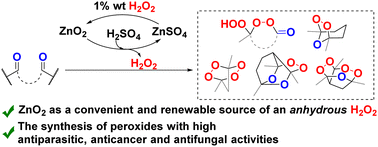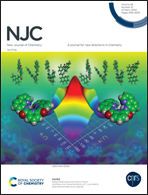Zinc peroxide as a convenient and recyclable source of anhydrous hydrogen peroxide and its application in the peroxidation of carbonyls†
Abstract
In this work, ZnO2 was unexpectedly discovered as a friendly and renewable source of anhydrous hydrogen peroxide in the acid-catalyzed synthesis of cyclic organic peroxides from carbonyl compounds. In particular, five classes of cyclic organic peroxides, namely, γ-hydroperoxy-γ-peroxylactones, β-hydroperoxy-β-peroxylactones, bridged ozonides, bridged 1,2,4,5-tetraoxanes, tricyclic monoperoxides, and tricyclic diperoxides, were synthesized in good yields using in situ generated H2O2 from the reaction of ZnO2 with H2SO4. This approach is convenient, safe, and does not require a concentrated aqueous or ethereal solution of H2O2. The starting ZnO2 was synthesized from zinc acetate using a 1 wt% H2O2 solution. The reaction of zinc peroxide with sulfuric acid in an organic solvent results in the release of hydrogen peroxide and the formation of zinc sulfate, which acts as a desiccant by forming a monohydrate phase, ZnSO4·H2O. The possibility of recycling zinc peroxide from zinc sulfate monohydrate with a high yield was shown.



 Please wait while we load your content...
Please wait while we load your content...